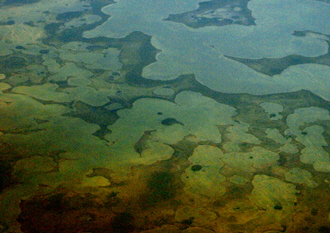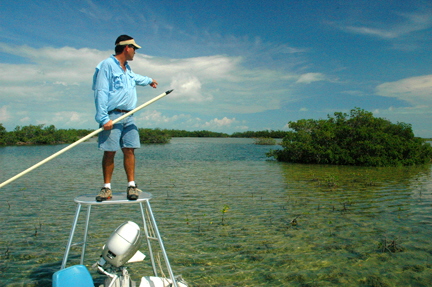|
The shallow area that Jody fishes is comprised of a bunch of little marls or marsh spits, little keys and large mangrove patches that are scattered around the flats in depths that range from just 2 inches down to 18 inches
or 2 feet. There are many fish in the extremely shallow waters, and while there are a few rocky areas, most of
the flats are mud with some interspersed turtle grass. The grassy areas are where the bones feed when the tide
is not dead low. Near the edge of the open water, there are a few slightly deeper places with sandy banks and wadable spots, but most of the area is "non wadeable".
 "The tide in the marsh, even well inside, is wind-driven," explains Jody, "and the wind can greatly
affect the tide movement and timing. The closer the angler gets to the outer cays of the marls near the open water, the more tidal flow there generally is.
The tide and water level can be high for a week or more before it goes back out. It just depends on how strong the wind is." "The tide in the marsh, even well inside, is wind-driven," explains Jody, "and the wind can greatly
affect the tide movement and timing. The closer the angler gets to the outer cays of the marls near the open water, the more tidal flow there generally is.
The tide and water level can be high for a week or more before it goes back out. It just depends on how strong the wind is."
There are almost 400 square miles of Great Abaco Island flats to fish in the marsh area called the Marls of Abaco, so there is a lot of water affected.
During a heavy duty cold front, the marsh waters can be two or three feet higher than normal, according to Jody. At other times, the entire flats can be a couple of feet shallower and almost bone
dry.
Under normal conditions, plenty of signs can reveal bonefish haunts. The blue-grey marks along the bottom in a spider web effect are indications that
the bonefish have recently been feeding, scooping up grass shrimp and crabs and stirring up the mud. As the fish swims along the bottom, it checks out all the crab
holes. It sucks up the morsels and also the mud, pushing it out of its mouth and gill flaps, which exposes the marl bottom leaving the unique bottom markings.
"You can easily see where the bonefish have moved through by looking for the blue gray mud areas," says Jody.
"The marks are generally not older than a day, so if you find streaks, you can generally find fish in that area."
While the bonefish are caught year around in the Marls, May is spawning season and that's when the guide
often finds huge schools of bones mudding in the open areas. There might be several hundred bonefish near the
surface spawning, and they eat extremely well then! At other times, the fishing might be more difficult.
On bright, sunny calm days, sometimes called, "picture perfect", the angler and guide can see the fish at great
distances. And, the bones can see them. As a result, the angler may not catch a lot more. On a bright, sunny day
with spinning tackle or fly, the actual shadow of your line or bait may spook the fish, but on a day that is slightly
overcast you won't experience that as much. On overcast days with a breeze, the angler may catch a few more
fish because his shadow isn't cast as far and the noise of the bait hitting the water may not spook the bonefish as easily.
 "On a completely overcast day, you can put the boat over the top of the fish," says Jody. "But then, you can't see the
fish until they're right in front of the bow. It's challenging either way, and rain makes it even more difficult to see the fish." "On a completely overcast day, you can put the boat over the top of the fish," says Jody. "But then, you can't see the
fish until they're right in front of the bow. It's challenging either way, and rain makes it even more difficult to see the fish."
Bonefish in the Marls like to move into the back of the tiny coves with the high tides. They move to the new feeding
areas that they have not poked around in since the previous high tide. They are on the move back to such areas to get fresher and more food. They sometimes take
up a position on the points of the mangrove bars when the tide is moving. If the current is too substantial, they move. Bonefish then will tuck in behind the points where the
current is swirling around them. In those pockets, they will wait for the current to bring forage to them.
There are large numbers of fish in the Marls year round. During February, March and April, in the slightly cooler
months, an angler will normally have more fish on the flats longer. The days are not as hot as in the summer
months, so the fish spend a good amount of time in the shallows. Summer is a little warm, so the bonefish don't
stay on the flats long. However, there are more good weather days then, so the angler's chances can be better than at other times.
The 30-year old guide often handles the bonefish bookings of Abaco Beach Resort & Boat Harbour where Dan
and I were staying. Jody fishes about 100 days a year and charges $300 for half day and $400 for a full day. He
currently has a 16-foot Carolina skiff with bow casting platform, center console with seat cooler combination, 45
hp outboard, and polling platform. The guide furnishes his clients with custom spinning rods and Shimano
spinning reels loaded with 20 pound test Power Pro line, but a lot of his customers are fly fishermen.
 Jody recommends a 12-pound tapered tippet of fluorocarbon line and size number 4 fly and hook. Rods of 7 to 9 weight are suggested, preferably a 7 or 8 weight on a
light wind day and a 9 weight on a windy day. Often, you won't know about the wind conditions until you go out to fish. The best flies are those that resemble
shrimp. Spinning anglers toss artificials such as the Berkley Gulp rubber shrimp and fresh, live shrimp, and most guides in the area have their own favorites. Jody recommends a 12-pound tapered tippet of fluorocarbon line and size number 4 fly and hook. Rods of 7 to 9 weight are suggested, preferably a 7 or 8 weight on a
light wind day and a 9 weight on a windy day. Often, you won't know about the wind conditions until you go out to fish. The best flies are those that resemble
shrimp. Spinning anglers toss artificials such as the Berkley Gulp rubber shrimp and fresh, live shrimp, and most guides in the area have their own favorites.
Fly fishermen still have the advantage though, according to Jody. For every bonefish that a spinning rod angler will
catch, a fly rodder will usually catch two, even in wet, cloudy conditions as my fishing buddy Dan proved to me!
There are numerous flights from Miami, Ft. Lauderdale and West Palm Beach airports, which lie only 45 to 60 minutes away. By boat, it lies just 160 miles
from West Palm. Boaters can find plenty of space in the Abaco Beach Resort Boat Harbor, the largest in the
Bahamas. The full service, 198-slip marina offers18- to 26-foot outboard-equipped boat rentals for those that
want to go out on their own and try some of the beach areas scattered about on the nearby islands. Little
Harbour and the mainland area between Witch Point and Sandy Cay just south of the resort offer excellent bonefishing. You can get out and wade many of these areas.
To find out more information on the bonefish packages offered by Abaco Beach Resort & Boat Harbour in the
Bahamas Out Islands, contact 1-800-753-9259 or visit their website at www.abacobeachresort.com. To contact Jody Albury Bonefishing Charters, phone 242-367-5119 or email captjea@hotmail.com.
Read Bonefish in the Southern Abacos – Part I
|